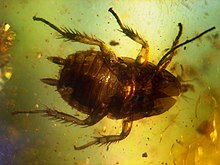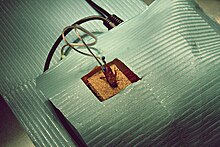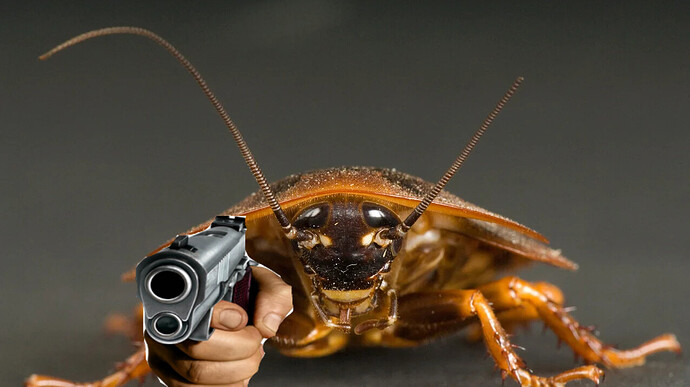Cockroach
Cockroaches (or roaches [1][2][3]) are insects of the order Blattodea, which also includes termites. About 30 cockroach species out of 4,600 are associated with human habitats. About five species are well known as pests.
The cockroaches are an ancient group, dating back at least as far as the Carboniferous period, some 320 million years ago. Those early ancestors however lacked the internal ovipositors of modern roaches. Cockroaches are somewhat generalized insects without special adaptations like the sucking mouthparts of aphids and other true bugs; they have chewing mouthparts and are likely among the most primitive of living Neopteran insects. They are common and hardy insects, and can tolerate a wide range of environments from Arctic cold to tropical heat. Tropical cockroaches are often much bigger than temperate species, and, contrary to popular belief, extinct cockroach relatives (Blattoptera) and ‘roachoids’ such as the Carboniferous Archimylacris and the Permian Apthoroblattina were not as large as the biggest modern species.
Some species, such as the gregarious German cockroach, have an elaborate social structure involving common shelter, social dependence, information transfer and kin recognition. Cockroaches have appeared in human culture since classical antiquity. They are popularly depicted as dirty pests, though the majority of species are inoffensive and live in a wide range of habitats around the world.
Taxonomy and evolution[edit]
A 40- to 50-million-year-old cockroach in Baltic amber (Eocene)
Cockroaches are members of the order Blattodea, which includes the termites, a group of insects once thought to be separate from cockroaches. Currently, 4,600 species and over 460 genera are described worldwide.[4][5] The name “cockroach” comes from the Spanish word for cockroach, cucaracha , transformed by 1620s English folk etymology into “cock” and “roach”.[6] The scientific name derives from the Latin blatta , “an insect that shuns the light”, which in classical Latin was applied not only to cockroaches, but also to mantids.[7][8]
Historically, the name Blattaria was used largely interchangeably with the name Blattodea, but whilst the former name was used to refer to ‘true’ cockroaches exclusively, the latter also includes the termites. The current catalogue of world cockroach species uses the name Blattodea for the group.[4] Another name, Blattoptera, is also sometimes used to refer to extinct cockroach relatives.[9] The earliest cockroach-like fossils (“blattopterans” or “roachids”) are from the Carboniferous period 320 million years ago, as are fossil roachoid nymphs.[10][11][12]
Since the 19th century, scientists believed that cockroaches were an ancient group of insects that had a Devonian origin, according to one hypothesis.[13] Fossil roachoids that lived during that time differ from modern cockroaches in that they had long external ovipositors and are the ancestors of mantises, as well as modern cockroaches. As the body, hind wings and mouthparts are not preserved in fossils frequently, the relationship of these roachoids and modern cockroaches remains disputed. The first fossils of modern cockroaches with internal ovipositors appeared in the early Cretaceous. A recent phylogenetic analysis suggests that cockroaches originated at least in the Jurassic.[13] Common Mesozoic stem-group cockroaches include the Blattulidae and Mesoblattinidae.
The evolutionary relationships of the Blattodea (cockroaches and termites) shown in the cladogram are based on Eggleton, Beccaloni and Inward (2007).[14] The cockroach families Anaplectidae, Lamproblattidae, and Tryonicidae are not shown but are placed within the superfamily Blattoidea. The cockroach families Corydiidae and Ectobiidae were previously known as the Polyphagidae and Blattellidae.[15]
Termites were previously regarded as a separate order Isoptera to cockroaches. However, recent genetic evidence strongly suggests that they evolved directly from ‘true’ cockroaches, and many authors now place them as an “epifamily” of Blattodea.[14] This evidence supported a hypothesis suggested in 1934 that termites are closely related to the wood-eating cockroaches (genus Cryptocercus ). This hypothesis was originally based on similarity of the symbiotic gut flagellates in termites regarded as living fossils and wood-eating cockroaches.[16] Additional evidence emerged when F. A. McKittrick (1965) noted similar morphological characteristics between some termites and cockroach nymphs.[17] The similarities among these cockroaches and termites have led some scientists to reclassify termites as a single family, the Termitidae, within the order Blattodea.[14][18] Other scientists have taken a more conservative approach, proposing to retain the termites as the Termitoidae, an epifamily within the order. Such a measure preserves the classification of termites at family level and below.[19]
Description[edit]
Domino cockroach Therea petiveriana , normally found in India
Most species of cockroach are about the size of a thumbnail, but several species are bigger. The world’s heaviest cockroach is the Australian giant burrowing cockroach Macropanesthia rhinoceros , which can reach 9 centimetres (3 1⁄2 in) in length and weigh more than 30 grams (1 oz).[20] Comparable in size is the Central American giant cockroach Blaberus giganteus .[21] The longest cockroach species is Megaloblatta longipennis , which can reach 97 mm (3 7⁄8 in) in length and 45 mm (1 3⁄4 in) across.[22] A Central and South American species, Megaloblatta blaberoides , has the largest wingspan of up to 185 mm (7 1⁄4 in).[23]
Head of Periplaneta americana
Cockroaches are generalized insects, with few special adaptations, and may be among the most primitive living Neopteran insects. They have a relatively small head and a broad, flattened body, and most species are reddish-brown to dark brown. They have large compound eyes, two ocelli, and long, flexible antennae. The mouthparts are on the underside of the head and include generalized chewing mandibles, salivary glands and various touch and taste receptors.[24]
The body is divided into a thorax of three segments and a ten-segmented abdomen. The external surface has a tough exoskeleton which contains calcium carbonate and protects the inner organs and provides attachment to muscles. It is coated with wax to repel water. The wings are attached to the second and third thoracic segments. The tegmina, or first pair of wings, are tough and protective, lying as a shield on top of the membranous hind wings, which are used in flight. All four wings have branching longitudinal veins, and multiple cross-veins.[25]
The three pairs of legs are sturdy, with large coxae and five claws each.[25] They are attached to each of the three thoracic segments. The front legs are the shortest and the hind legs the longest, providing the main propulsive power when the insect runs.[24] The spines on the legs were earlier considered to be sensory, but observations of the insect’s gait on sand and wire meshes have demonstrated that they help in locomotion on difficult terrain. The structures have been used as inspiration for robotic legs.[26][27]
The abdomen has ten segments, each with a pair of spiracles for respiration. Segment ten bears a pair of cerci, a pair of anal styles, the anus and the external genitalia. Males have an aedeagus through which they secrete sperm during copulation and females have spermatheca for storing sperm and an ovipositor through which the ootheca are laid.[24]
Distribution and habitat[edit]
Cockroaches are abundant throughout the world and live in a wide range of environments, especially in the tropics and subtropics.[28] Cockroaches can withstand extremely low temperatures, allowing them to live in the Arctic. Some species are capable of surviving temperatures of −122 °C (−188 °F) by manufacturing an antifreeze made out of glycerol.[29] In North America, 50 species separated into five families are found throughout the continent.[28] 450 species are found in Australia.[30] Only about four widespread species are commonly regarded as pests.[31][32]
Cockroaches occupy a wide range of habitats. Many live in leaf litter, among the stems of matted vegetation, in rotting wood, in holes in stumps, in cavities under bark, under log piles and among debris. Some live in arid regions and have developed mechanisms to survive without access to water sources. Others are aquatic, living near the surface of water bodies, including bromeliad phytotelmata, and diving to forage for food. Most of these respire by piercing the water surface with the tip of the abdomen which acts as a snorkel, but some carry a bubble of air under their thoracic shield when they submerge. Others live in the forest canopy where they may be one of the main types of invertebrate present. Here they may hide during the day in crevices, among dead leaves, in bird and insect nests or among epiphytes, emerging at night to feed.[33]
Relationship with humans[edit]
Cockroaches in research: Periplaneta americana in an electrophysiology experiment
In research and education[edit]
Because of their ease of rearing and resilience, cockroaches have been used as insect models in the laboratory, particularly in the fields of neurobiology, reproductive physiology and social behavior.[34] The cockroach is a convenient insect to study as it is large and simple to raise in a laboratory environment. This makes it suitable both for research and for school and undergraduate biology studies. It can be used in experiments on topics such as learning, sexual pheromones, spatial orientation, aggression, activity rhythms and the biological clock, and behavioral ecology.[62] Research conducted in 2014 suggests that humans fear cockroaches the most, even more than mosquitoes, due to an evolutionary aversion.[63]
As pests[edit]
The Blattodea include some thirty species of cockroaches associated with humans; these species are atypical of the thousands of species in the order.[64] They feed on human and pet food and can leave an offensive odor.[65] They can passively transport pathogenic microbes on their body surfaces, particularly in environments such as hospitals.[66][67] Cockroaches are linked with allergic reactions in humans.[68][69] One of the proteins that trigger allergic reactions is tropomyosin.[70] These allergens are also linked with asthma.[71] About 60% of asthma patients in Chicago are also sensitive to cockroach allergens. Studies similar to this have been done globally and all the results are similar. Some species of cockroach can live for up to a month without food, so just because no cockroaches are visible in a home does not mean that they are not there. Approximately 20–48% of homes with no visible sign of cockroaches have detectable cockroach allergens in dust.[72]
On rare occasion cockroaches can crawl into human ears, causing pain and hearing loss.[73][74] They may be removed with forceps, possibly after first drowning with olive oil.[75][76][77]
Control[edit]
Many remedies have been tried in the search for control of the major pest species of cockroaches, which are resilient and fast-breeding. Household chemicals like sodium bicarbonate (baking soda) have been suggested, without evidence for their effectiveness.[78] Garden herbs including bay, catnip, mint, cucumber, and garlic have been proposed as repellents.[79] Poisoned bait containing hydramethylnon or fipronil, and boric acid powder is effective on adults.[80] Baits with egg killers are also quite effective at reducing the cockroach population. Alternatively, insecticides containing deltamethrin or pyrethrin are very effective.[80] In Singapore and Malaysia, taxi drivers use pandan leaves to repel cockroaches in their vehicles.[81]
Some parasites and predators are effective for biological control of cockroaches. Parasitoidal wasps such as Ampulex wasps sting nerve ganglia in the cockroach’s thorax, causing temporary paralysis and allowing the wasp to deliver an incapacitating sting into the cockroach’s brain. The wasp clips the antennae with its mandibles and drinks some hemolymph before dragging the prey to a burrow, where an egg (rarely two) is laid on it.[82] The wasp larva feeds on the subdued living cockroach.[83][84] Another wasp considered to be a promising candidate for biological control is the ensign wasp Evania appendigaster , which attacks cockroach oothecae to lay a single egg inside.[85][86] Ongoing research is still developing technologies allowing for mass-rearing these wasps for application releases.[87][88] Widow spiders commonly prey on cockroaches[89][90] though their venomous bite introduces its own problems for humans and pets.
Cockroaches can be trapped in a deep, smooth-walled jar baited with food inside, placed so that cockroaches can reach the opening, for example with a ramp of card or twigs on the outside. An inch or so of water or stale beer (by itself a cockroach attractant) in the jar can be used to drown any insects thus captured. The method works well with the American cockroach, but less so with the German cockroach.[91]
A study conducted by scientists at Purdue University concluded that the most common cockroaches in the US, Australia and Europe were able to develop a “cross resistance” to multiple types of pesticide. This contradicted previous understanding that the animals can develop resistance against one pesticide at a time.[92] The scientists suggested that cockroaches will no longer be easily controlled using a diverse spectrum of chemical pesticides and that a mix of other means, such as traps and better sanitation, will need to be employed.[92]
As food[edit]
See also: Entomophagy and Cockroach farming
Although considered disgusting in Western culture, cockroaches are eaten in many places around the world.[93][94] Whereas household pest cockroaches may carry bacteria and viruses, cockroaches bred under laboratory conditions can be used to prepare nutritious food.[95] In Mexico and Thailand, the heads and legs are removed, and the remainder may be boiled, sautéed, grilled, dried or diced.[93] In China, cockroaches have become popular as medicine and cockroach farming is rising with over 100 farms.[96]
The cockroaches are fried twice in a wok of hot oil, which makes them crispy with soft innards that are like cottage cheese.[97][98] Fried cockroaches are ground and sold as pills for stomach, heart and liver diseases.[99] A cockroach recipe from Formosa (Taiwan) specifies salting and frying cockroaches after removing the head and entrails.[100]
In traditional and homeopathic medicine[edit]
In China, cockroaches are raised in large quantities for medicinal purposes.[101]
Two species of cockroach were used in homeopathic medicine in the 19th century.[102]
Conservation[edit]
See also: Depopulation of cockroaches in post-Soviet states
While a small minority of cockroaches are associated with human habitats and viewed as repugnant by many people, a few species are of conservation concern. The Lord Howe Island wood-feeding cockroach ( Panesthia lata ) is listed as endangered by the New South Wales Scientific Committee, but the cockroach may be extinct on Lord Howe Island itself. The introduction of rats, the spread of Rhodes grass ( Chloris gayana ) and fires are possible reasons for their scarcity.[103] Two species are currently listed as endangered and critically endangered by the IUCN Red List, Delosia ornata and Nocticola gerlachi .[104][105] Both cockroaches have a restricted distribution and are threatened by habitat loss and rising sea levels. Only 600 Delosia ornata adults and 300 nymphs are known to exist, and these are threatened by a hotel development. No action has been taken to save the two cockroach species, but protecting their natural habitats may prevent their extinction. In the former Soviet Union, cockroach populations have been declining at an alarming rate; this may be exaggerated, or the phenomenon may be temporary or cyclic.[106] One species of roach, Simandoa conserfariam , is considered extinct in the wild.





